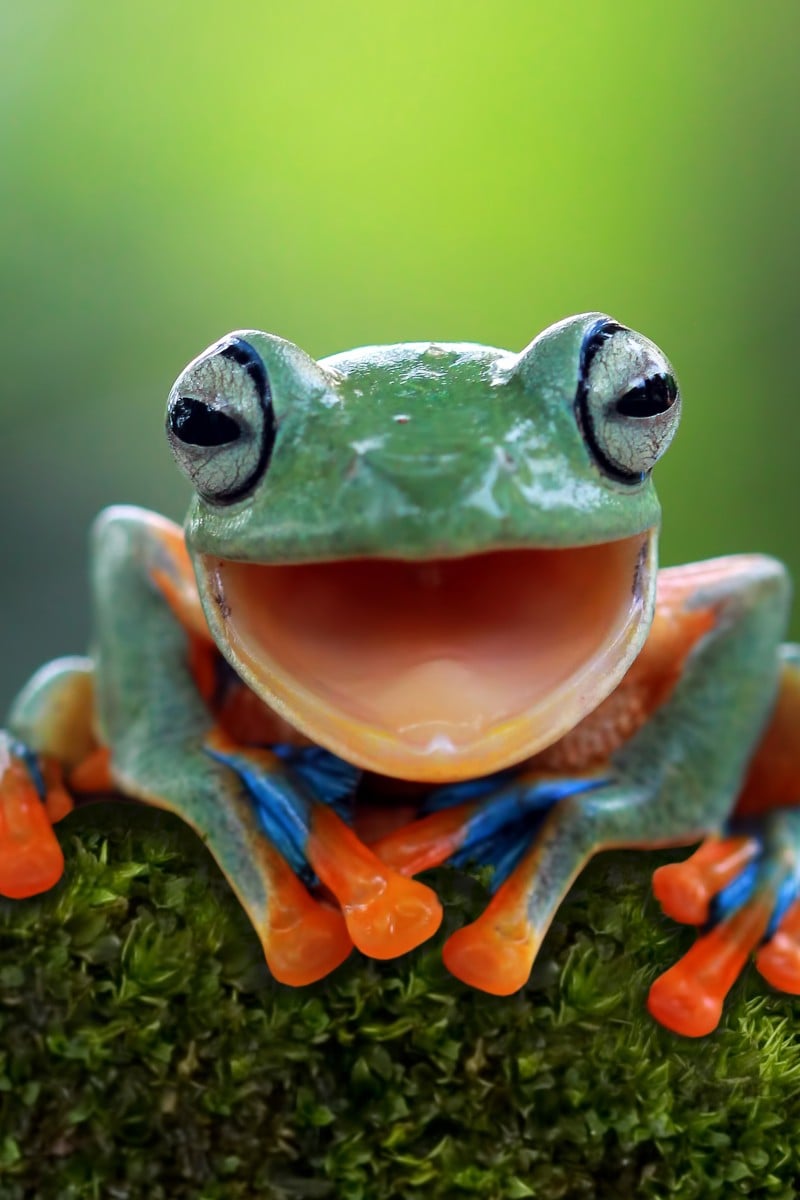
- These slippery swimmers play an important part in the Earth’s ecosystem and help control diseases like malaria, Zika virus and dengue fever
- There are many frog species in Hong Kong, like the Asiatic painted frog and the Green cascade frog
 This happy little tree frog wants you to have a wonderful World Frog Day!
This happy little tree frog wants you to have a wonderful World Frog Day!March 20 is World Frog Day, and we’ve put together some fun facts in celebration of our ribbiting, hippity-hoppity friends.
Most species have a visible ear drum on each side of their head called a tympanum, which sends sound waves to the frog’s inner ear and protects it from dirt and water. It’s also one way of telling male frogs apart from female ones. Girl frogs have a tympanum that’s smaller than their eye.
7 endangered species here in Hong Kong
You can identify frog species by listening to their call, and these can differ from one region to another, just like human accents. From high-pitched whistles, to a ducklike “ca-ha-ha-ac” cackling, or a rattling snore, male frogs sing to warn others of predators, defend their territory, and find mates.
That’s not all. Female frogs’ ears are specially tuned to detect the mating calls of their own species, so that they can find their mate in an army (yup, that’s what you call a group of frogs) of multiple, noisy males.
Most frogs only have teeth on their upper jaw, which they use to hold onto their prey until they decide to eat them and they literally eat in the blink of an eye.
May you be as happy as this White-lipped tree frog.
When a frog swallows its prey, it blinks and pushes its eyeballs down into their sockets. This puts pressure on the top of the frog’s mouth, and helps push the food into its throat!
Frogs don’t need to drink water because they absorb it directly through an area on their skin called the “drinking patch”. It is on their belly and the underside of their thighs.
They secrete substances through their skin, too! Some of these liquids can be used to create antibiotics and painkillers – their skin contains powerful germ-fighting substances because of the hostile environments they live in. Some, like the poison dart frog, give off toxins so powerful that even a slight touch can be deadly.
Group of grey whales learns smart new feeding strategy during migration
These cold-blooded animals hibernate during winter as they cannot produce their own body heat, and you can tell the number of times a frog has done this. Frog bones form a new ring every year when the frog is hibernating, just like trees do. Scientists can count the rings to find out how old a frog was.
Last but not least, frogs play a very important role in ecosystems both as prey and predator. Tadpoles eat algae and keep our rivers and canals clean. Full-grown frogs feed on insects, such as grasshoppers, flies, crickets and mosquitoes, and help control their numbers while keeping diseases such as malaria, Zika and dengue at bay.
Two-thirds of tropical rainforest lost worldwide
Unfortunately, it’s estimated at least 200 frog species have gone extinct since 1970 due to habitat loss, climate change and rise of deadly diseases that wipe out entire frog populations. Scientists and wildlife activists are scrambling to save them from extinction before it’s too late.
Here are some frogs you can find right here in Hong Kong:
Hong Kong newt
The only native amphibian in Hong Kong with a tail, the Hong Kong newt can be found in parts of the New Territories such as Tai Mo Shan and Shing Mun, Tai Tam Reservoir on Hong Kong Island, and Lantau Island. Breeding males have a blue streak on their tail, which disappears after breeding.
Photo: Wildcreatures Hong Kong
Asian common toad
Like its name suggests, the Asian common toad is the most common amphibian species in Hong Kong. It’s call sounds like an old fashioned telephone dial tone. This brown chubby fella has a hidden talent, too – it’s really good at climbing trees. It secretes a milky poison that kills predators.
Photo: Benjamin Marshall
Asiatic painted frog
Easily identified by the orange markings on its back, this medium-sized frog mostly lives in forests and near ponds. It’s often traded as a pet, under the name “chubby frog”. If you do find one, leve it alone.
When disturbed, it will blow up its body and release a sticky white substance from its skin.
Photo: SCMP
Green cascade frog
Commonly seen in Tai Po Kau, Tai Mo Shan, and parts of Hong Kong Island such as Lung Fu Shan and Tai Tam Reservoir, this little green frog is not one to be trifled with. Just like its brown cousin, the green cascade frog secretes a milky, poison to protect itself. It’s also known to kill other frogs.
Photo: SCMP
Giant spiny frog
The largest frog in Hong Kong, the male giant spiny frog has short spines on its chest and fingers. Often found resting on rocks in streams, it enjoys snacking on freshwater crabs and insects. It’s often harvested by humans for food, and there have been attempts to farm it on the mainland.
Photo: HKU
